Select one of the previous four assignments as the starting point for your personal project:
The options are:
- line, space and form
- your immediate environment
- outdoors
- figure and face
Life study drawing is a constraint, as access to a model is difficult. I prefer to use the outdoors and landscape to explore and experiment from there. Working outside will involve preparation and I should have a clear sense of intention, but I also feel I should allow my intuitive side to be open to imagining and exploring ideas I decide to present in the drawing(s). The weather is still good to be outside and I am interested in using video and photo material during this drawing process, and do some of the work at home.
During the course I was encouraged by my tutor to experiment with marks and lines and to use my own sensitivity at combining materials, media, colour and techniques to create my own visual language. I loved the research work and learning from other artists with regards to knowledge on how to develop my own drawings/studies and their varying visual language. Whilst living in the UAE, Dubai now for 6 months, I have been challenged to learn about a new country, its history and culture which is very tightly connected to its landscape and religion. The UAE is made up of a federation of seven emirates (Abu Dhabi, Dubai,Sharjah, Ajman, Ras Al Khaimah, Fujairah and Umm Al Quwain) and covers an area of nearly 83,600 km² . It is roughly the size of Austria. The country shares land borders with Saudi Arabia and Oman, and its coastal areas include parts of the Arabian Gulf to the west and the Gulf of Oman to the east. Eighty percent of the UAE is desert, the three main ecological areas are: northeastern mountain areas, sandy/ desert areas, and marine coastal areas.
The cityscape is interesting as it gives an almost ‘deceptive’ idea of actual location – one easily forget the desert around you. The play of shadows on the skyscrapers is always a reason for me to grab my camera. I recently started drawing on my iPad – have not been for any formal tuition, but it is as if it works perfectly for the cityscape ideas that are developing.




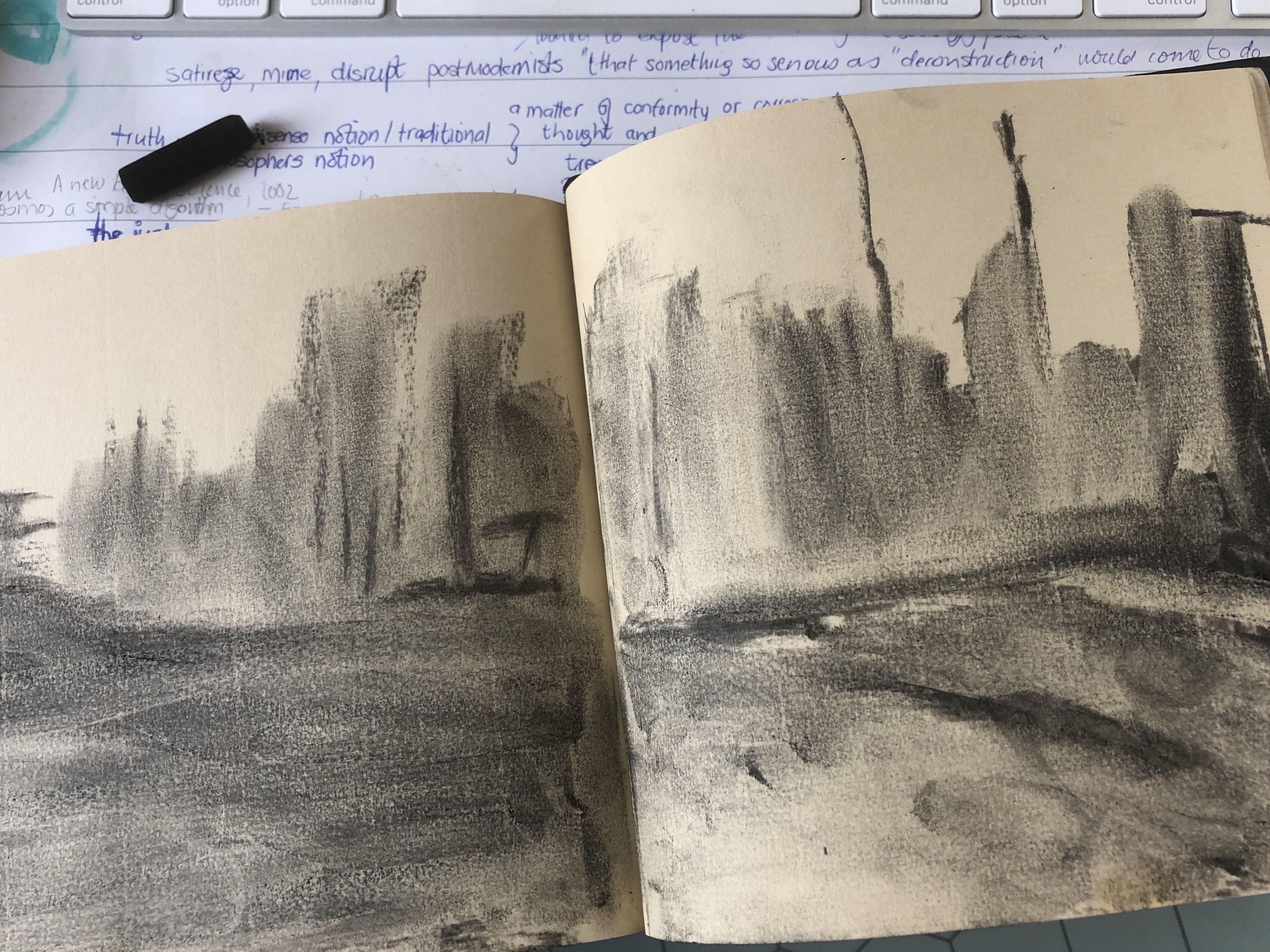
Above is a quick sketch after an impulsive stop from the main road and a quick snap – the big city is a clear reminder of the desert landscape and the effort to create sustainable living in very harsh conditions of nature.
Exploring ideas around my environment also include the trees that have been planted extensively in the city as well as those naturally in the desert landscape. I enjoy the palm trees for their variety and significance in this culture. My husband and I love to spend time in the desert – during the last few months, it is a mild winter here, we had wonderful opportunities to go into the desert to observe and be touched by the beauty and feeling to be there.

I long for the natural wilderness areas of Southern Africa and wonder how I will develop my rhino project into my life whilst living in the UAE. At heart I am an activist for nature and want to stay as close possible to things concerning the natural world.

The UAE averages less than 100 mm rainfall a year. With heat and high evaporation, the result is that groundwater resources are limited and under stress. Climate change, population growth, and increasing agriculture also exhaust groundwater resources, collaborate collective efforts are made to preserve resources and protect nature. I read that the indigenous Ghaf tree, also the national tree, will send its roots 30 meters to access water, and because of its extensive root system, it stabilises shifting sand dunes and is also useful as a windbreak and in forestation of dry areas. Here I sense the fine balance within nature and the interconnectivity of complex systems within nature.
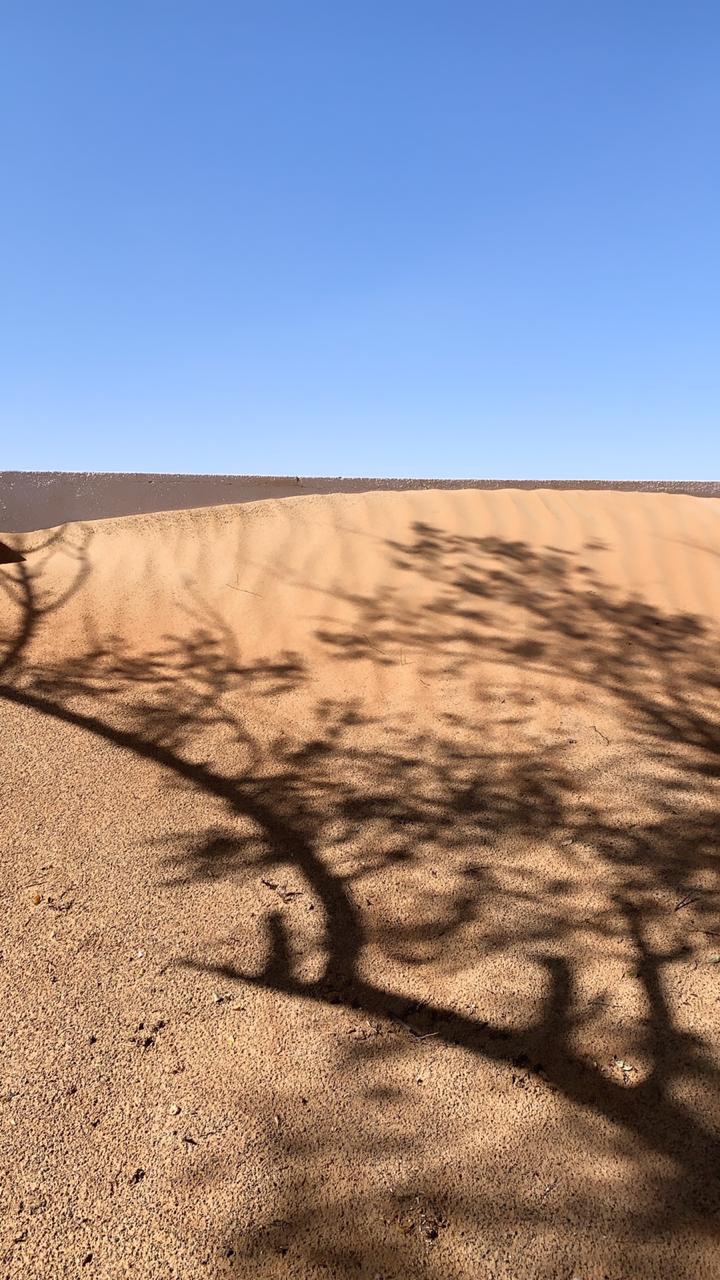
Laws and regulations prohibit the cutting of the tree throughout the country. A further significance is the cultural history that tribes gathered under the shadows of the ghaf trees to discuss their daily matters and therefore this tree symbolises stability and peace. The Ghaf tree is of historical importance because it was used in traditional medicine, its fruit and leaves were used as food for people and their cattle, and it also increases the oxygen level and helps reduce dust in the desert. The Ghaf flower can be used to prevent miscarriages, while its residue extract from the stem contains anti-inflammatory properties. The bark of the tree was also traditionally used to treat bronchitis, asthma, leucoderma and muscle tremors. I like botanical illustration and have always admired the process of documenting species in terms of their form, colour and details and the display thereof as prints, in collectors books or works of art. I am thinking of using the patterns of interesting architectural designs as a type of background to a drawing of lines of the city scape and add trees to the drawing.
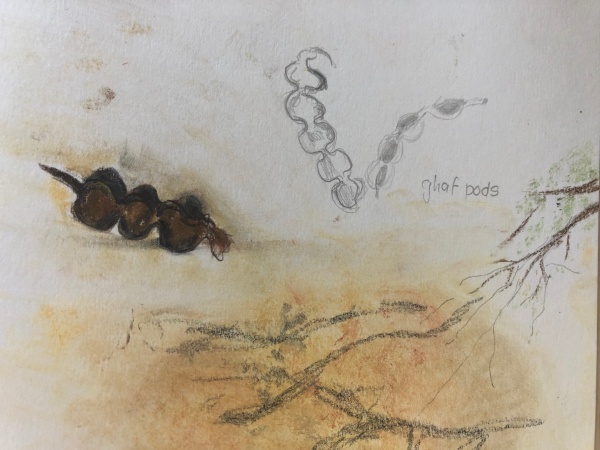
The Creek
As my ideas developed I spend more time in the oldest part of Dubai, where I found the historic Al Fahidi at the Dubai Creek area, with Deira on one side and Bur Dubai on the other. The Creek is about 14 km long, with its origin in the Persian Gulf. The area has many small museums, tea houses, art galleries, exhibition areas, hotels, old style souqs which sell spices, textiles and gold, as well as a mosque.
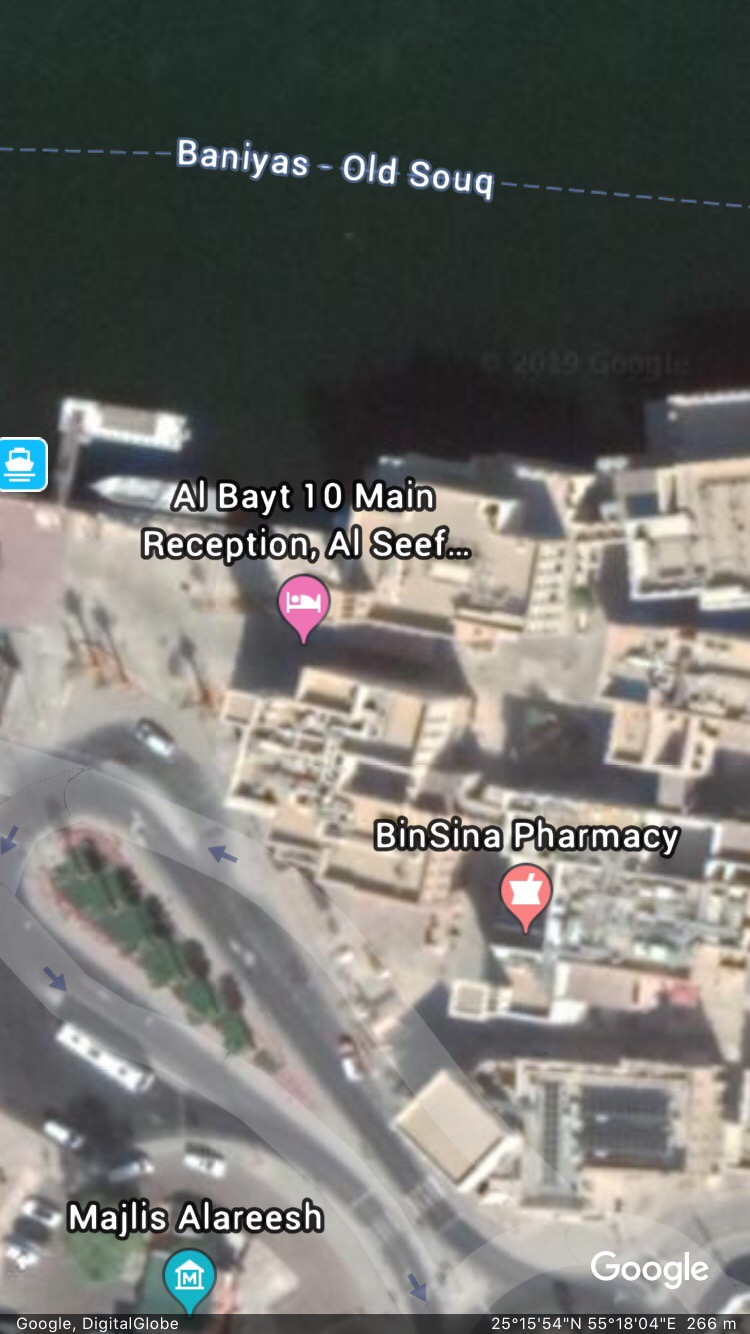
Many people also life here in flats and apartments. During the early 1970’s the Creek, which is a natural water inlet, was dredged to allow the passage of large vessels.

The migration of sea and waterbirds started around December and I found myself more immersed in these vistas happening around the inland water and salt marshes.

(photo from Middleeastmasala WordPress blog site, dated14 January 2014)
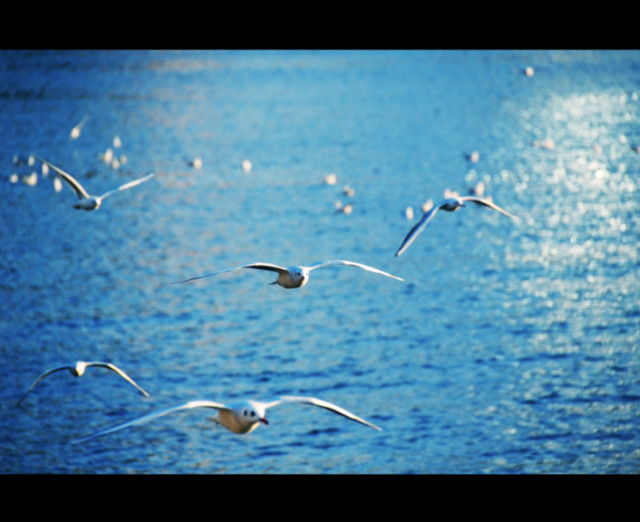
According to the BirdLife Data Zone website, at least 27 seabird species migrate into the UAE area yearly. The seabirds I captured in my final drawing is the Black headed gull ( Larus Ridibundus) This gull is 38–44 cm long with a 94–105 cm wingspan. In flight, the white leading edge to the wing is a good field mark. ( for the record, I am an avid birder – refer back to my first drawing of my favourite things on my camping chair – my Zeiss binoculars are in the bag. Think I have ticked off more than 330 birds in Southern Africa since the early 80’s) The local UAE birdwatching group entered 326 bird species listed in Dubai during 2018

The summer adult has a chocolate-brown head (does looks black from a distance), pale grey body, black tips to the primary wing feathers, and red bill and legs. The hood is lost in winter, leaving just 2 dark spots. Wikipedia states the following: “The black-headed gull is a bold and opportunistic feeder. It eats insects, fish, seeds, worms, scraps, and carrion in towns, or invertebrates in ploughed fields with equal relish. It is a noisy species, especially in colonies, with a familiar “kree-ar” call. Its scientific name means laughing gull.” I think the noisiness adds to the liveliness of this area.

My first drawing attempts were made with my new Ipad – I tried to capture the mood and questioning myself why I prefer this area and if this would be the place.
- I begin to understand that I was looking for inspiration in the character en textures of the landscape in front of me –
- I love being an onlooker/observer/documenter and also
- trying to think about the history of this place and
- the stories it could share.
It was early in the day and quiet, very few people around and I walked into open doors, peeped onto interesting views saw beautiful carpets and wooden carvings in lovely spaces – wooden oars of old boats, old fishing nets ( which I later learned to be ‘gargoor’ nets) were used as decorative pieces as well as carvings on the wooden doors kept me busy. I walked up small stairways to find lovely vistas of the Creek and the area surrounding, all alive with the daily business of people shopping, selling, unloading goods from boats and water taxis carrying people across.
I have read a few newspaper articles about the people living in this area and their relationship with the seagulls – it is almost an announcement of winter – time to spend more time outside as the weather is now much cooler. My dentist is an avid photographer and said she would share some of here photos with me. I have gone through a process of doubt with regards to my final choice, but the movement around this old busy fishing and trading area needed to be developed into my project.
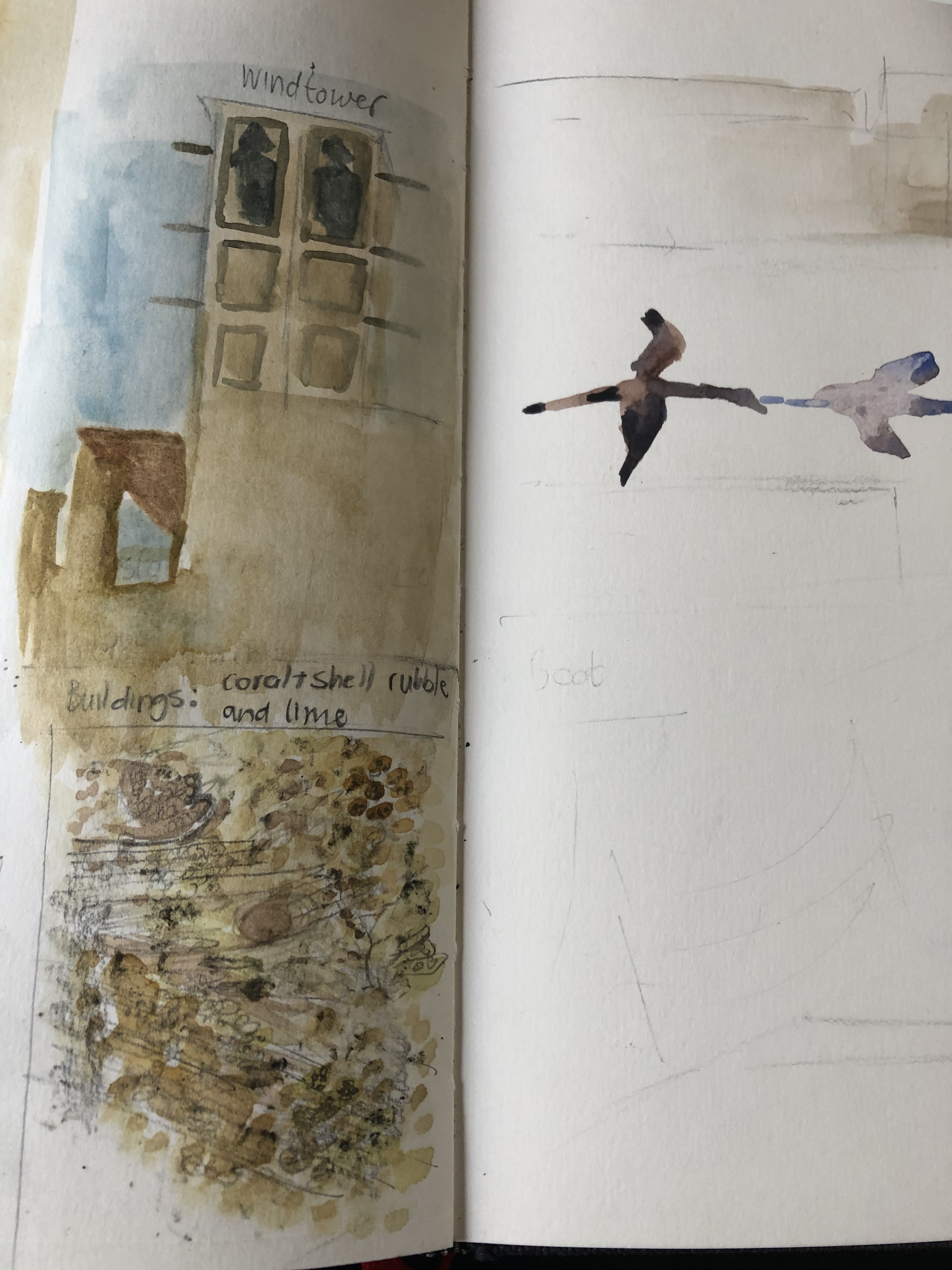
Fascinating about the old buildings is how ‘rubble’ from coral and sea shells, mixed with lime was used to build the walls. I think this was working with what they had at that stage – the desert landscape around the creek is not rocky and building materials from the surroundings would be wood from palm and other trees, as well as sand and the coral rock stones. I later picked up some pieces in areas outside Dubai – it feels and looks like fossils. I felt the use of my charcoal blocks can give the impression of the faded limestone cladded buildings and the old worldly feeling I have when visiting this area.

The Al Seef area has beautiful views around every corner! I imagined the flamingos flying to Ras Al Khor Wildlife area – where the Creeks flows into.
See map below of the Ras Al Khor Wildlife area. The Creek is the blue water area outside of the green marked wildlife area and goes all the way down to the coastline.

I am left in awe at how the migratory birds find their flyways here in this harsh landscape.
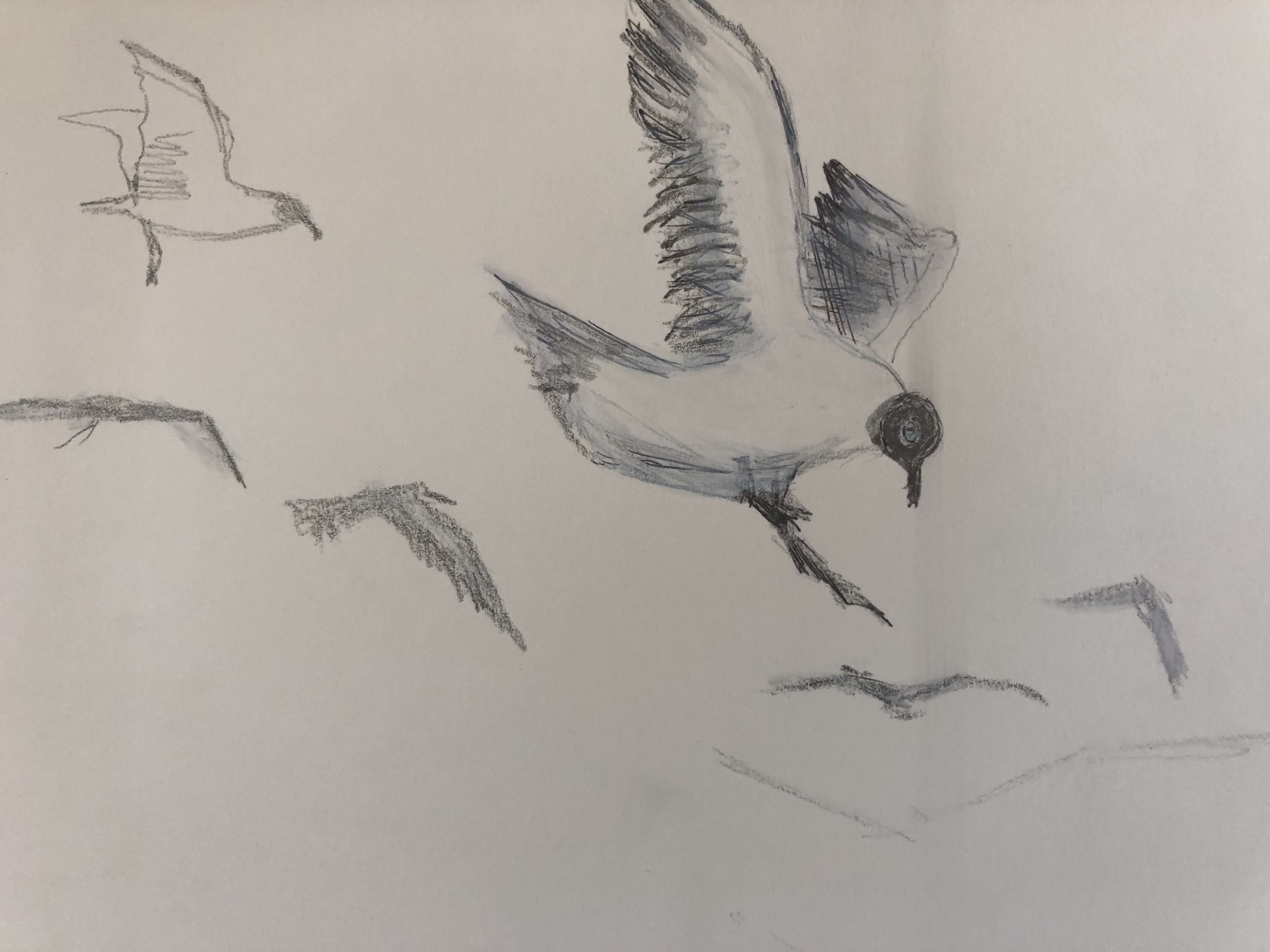
I read the following in a local newspaper: “The UAE, which is part of the Eurasian and Central Asian flyways , has long been a preferred destination for these winged travellers because of its abundant marine food sources, lagoons and mudflats. The country is blessed with milder coastal climates in winter and its inland waterways and mangroves, and salt marshes are important layovers for birds fleeing the icy regions. Birds use the sun to orientate during the day, and the stars at night, as well as geomagnetic field at any time. Some species can even detect polarised light, which many migrating birds may use for navigation at night.” It is clear that the Central Asian Flyway is the shortest flyway in the world. It lies entirely within the Northern Hemisphere and is 34,089,399 square kilometres and includes 29 countries. The UAE government is party to various animal conservation agreements including CITES, and is currently implementing the UAE National Biodiversity Strategy and Action Plan, 2014-2020.
ABU DHABI // The UAE has signed the Convention on Migratory Species during 2016 that will see the country build on its work in animal conservation at a global level. (The National, May 2016, online newspaper article)
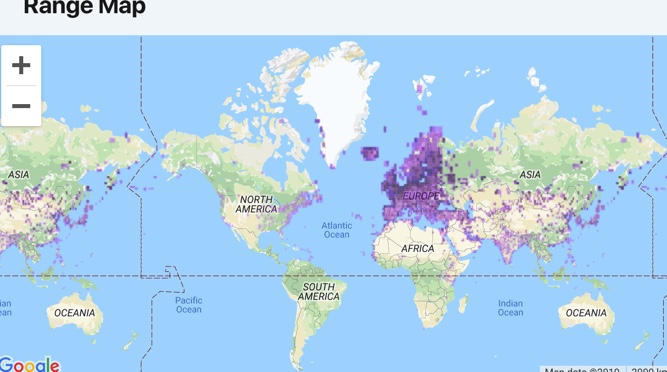
Above map shows where in the Northern Hemisphere the Black headed gulls appear. ( I added this after my tutor’s feedback)
It became interesting to read that migratory animals include dozens of species of mammals as well as an estimated two to three million birds which pass through the UAE every year, escaping the winter chill of central Asia for Africa and India; very much like the tourists seeking the beaches of Dubai. I here added more reading after my tutors report and thinking about themes of “migration, nature, architecture and your interest in observing parallels between human, animal behaviours, politics and cultures, has more potential for and has a thread back to your rhino project.” My tutor inspired me here to look at these research threads to explore further. I realised that my choice subject is so part of self study I undertake to understand my own concerns and connection with the natural world.
In a May 2018 National Geographic there was a photo placed by David Ellingsen, called the Living Planet. The word “ anthropocene‘ grabbed my imagination.. Anthro refers to how people have altered the planet. The photographers work reflect on both hope and concern about how our species is remaking the planet! Here is a link to view his work:
After my feedback from my tutor I was challenged to research my own artistic intentions with even more passion. I did a google search on the term ‘anthropocene as a geological epoch”. The following statement hit me like a wave in the ocean: ” …anthropocene as a formal unit in the geological timescale – not defined by human impacts on Earth, but by whether those impacts have produced suitable signals in the stratal record.” This search led to another – I found an artist who worked and exhibited here in the UAE during November 2016 – the name of this photographic exhibition was: The Anthropocene! The following was taken directly from this website:
The Anthropocene is an apt subject for the UAE – it’s the designation of the geological epoch denoting the current geological age, the period during which human activity has been the dominant influence on climate and the environment. In this country we have a landscape that for so long time remained almost entirely in its ‘natural’ state, with dramatic changes happening only in the past few years as man imposes himself on it.
As Allenby-Pratt puts it in his statement “the arrival of oil wealth fuelled an unprecedented economic boom and the exponential development has left barely any corner of the country untouched: the coastlines have been remodelled and the mountains ground up for the building aggregates that have created the futuristic cities”.

Above is two satellite images of Dubai, the left one was taken in in 1990 and in 2006 on the right. I found these images on the site of the Dailymail.co.uk (downloaded on 15 May 2019). The Creek is the water area that flows into the land and ends in a wider water-filled area – this is in the middle of the coastline as pictured above. One can clearly see how the landscape changed due to urbanisation. The birds arrive across the Persian Gulf to the Creek.
Dubai Art Fair and Migration ideas developing
During March Dubai had an Art Fair and a recurring theme in the work of many of the artists, were displacement, migration and fragmentation – I picked up on geographical ambiguity and the commonality of human suffering within areas/zones/countries where they life – about migration and crossing borders.
Below are some photos of the art week in Dubai:


Added after my tutors feedback: ‘… was there a piece of work in the fair that you connected with?” Both these artists do not live in their home countries and are living as migrants and telling stories about their pain and the history of their culture which is being threatened by occupation, dis owning of land and war. These artist inspire my own artistic intention of getting real about how my ambivalence with human idea of freedom and our connections and interaction with nature. My tutor reminded me ‘…still scope to uses this to help you experiment with materials and approaches.”
Word play in the last work, below, was done by a local born artist, Al Amri. Here she uses a delicate motorised copper sculpture of Arabic letters, one of which ticks back and fort, changing the meaning of the word over and over again. The word means thinking and then changes to meaning banished! The idea is to contemplate change, rather than taking an extreme side. We live in a volatile area of the world where extremism is a big threat to nature as well as humans.
[wpvideo hlwsXBye]
In a way this city reminds me of the migratory birds – at least 90% of the the city’s population are expats and migrant workers, who will never stay here permanently. This push-pull towards the city is part of economic growth and the challenge is the sustainability and balance it brings to this natural landscape. We also live in an increasingly connected world, just imagine what cellular phone data can contribute with regards to data of movement and recording. The following information was gathered from a WWF report: Expatriates made up 88.5% of the total UAE population of 8.3 million individuals in 2010 (National Bureau of Statistics, 2012). Increased urbanisation is the trend, the proportion of the population living in urban areas by 2013 was above the global average at 85%. It is understandable that in order to accommodate the rapid population increase, urbanisation was scaled up, which in turn results in pressures on terrestrial and marine environments (World Bank, 2015).
My research took me to a report on world migration of humans and here I am aware of a very complex situation that is unfolding. Migration encompasses a wide variety of movements and situations that involve people of all walks of life and backgrounds. More than ever before, migration touches all states and people in an era of deepening globalisation, and is intertwined with geopolitics, trade and cultural exchange. Migration provides opportunities for states, businesses and communities to benefit enormously. Migration has helped improve people’s lives in both origin and destination countries and has offered opportunities for millions of people worldwide to forge safe and meaningful lives abroad. Not all migration occurs in positive circumstances, however. We have in recent years seen an increase in migration and displacement occurring due to conflict, persecution, environmental degradation and change, and a profound lack of human security and opportunity.
The World Migration Report 2018 use the body of available data and research on migration to contribute to more evidence-based analysis and policy debates about some of the most important and pressing global migration issues of our time. According to this report the current global estimate is that there were around 244 million international migrants in the world in 2015, which equates to 3.3 per cent of the global population – this is a very small minority of the global population, meaning that remaining within one’s country of birth overwhelmingly remains the norm.

The current wars in Syria and Iraq have produced the greatest share of the Middle East’s refugees in recent years, but many more have fled wars and failed states in Afghanistan, Libya, Somalia, Sudan, and Yemen. Neighbouring states are facing severe challenges in absorbing millions of refugees, while North African states and Turkey have emerged as key transit hubs for refugee flows into Europe.
My tutor challenged my creative thoughts in his feedback, to look at the migration maps and data.

Interesting to read was that the Central Asia/South Asia flyway area is about 34,089,399 square kilometres and includes 29 countries. The Central Asia Flyway is the shortest flyway in the world and more than 300 species travel along this Flyway, and it is also the most poorly studied flyway. The gulls come mostly from the UK, Iceland and northern Eurasia.
Below is a map indicating the range of the Gulls in the UAE – it is also clear from this data that there are more gulls in Dubai and Abu Dhabi – reasons could be the natural habitat with marshes and water ways. (added after tutor’s feedback – attempt to learn more about the maps and to integrate it in a drawing)

I tried to understand if these gulls also fly in V formation – what I saw was chaos.

Black headed Seagull migration
It is estimated that between 2 000 – 10 000 birds visit this area yearly. Interesting to note is that these birds frequent the Ras Al Khor Wildlife area, which is a Ramsar Wetland site and is adjacent to the Creek area, and is about 620 hectares in size. The birds are seen in the city, at the beaches and in the Creek area. Construction ( man-made structures such a powerlines) pollution, and disturbance are main threats to these birds who come to breed during winter – these wetlands are important as many are shrinking due to the diversion of rivers for agriculture and the depletion of groundwater. Monitoring data is clearly important to upkeep. The following information I found in the 2018 report of AEWA ( Agreement of the African-Eurasian Migratory Waterbirds) was interesting: “The key finding is that the strongest predictor of change in waterbird abundance globally is the effective governance of the country. This was measured through the World Bank’s Worldwide Governance Indicators that summarises six broad dimensions of governance: Voice and Accountability, Political Stability and Absence of Violence, Government Effectiveness, Regulatory Quality, Rule of Law and Control of Corruption.
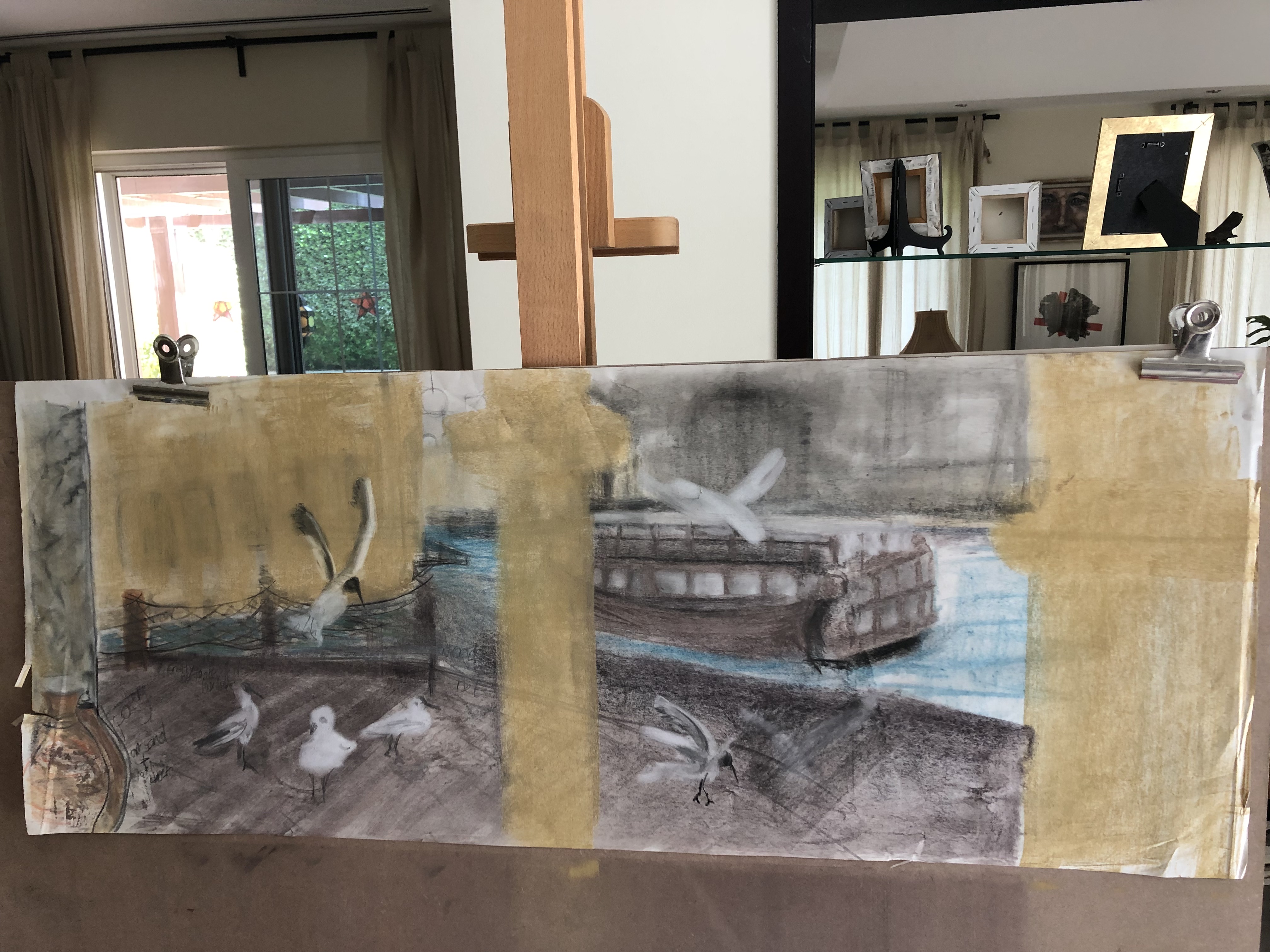
Below are flamingos -Khor Dubai holds some hundreds of Flamingos, which migrate north to their Iranian and Russian breeding colonies.

Numbers are however kept artificially high by feeding. (this information was taken from a 1995 report on the wetlands in the UAE) According to a strategy document of the Emirates Nature WWF, the UAE is home to resilient ecosystems where economic progress is complemented with practical actions to safeguard biodiversity. We humans tend to create and interfere with nature. – one of my biggest questions to conservation is how do we let nature be, if we also need to be? My tutor saw this paragraph “… a good bit of reflection ……Good.” Whilst looking at my composition I am asking myself what am I trying to say with this drawing – in a way I am almost obsessing over the subject. I am thinking about natural versus forced migration. I am thinking about modern versus the old – I am happy the city’s leadership placed and emphasis on cultural museums and not demolishing the old for the new and modern skyscrapers and amazing architectural designs of the contemporary buildings. In the composition I want the keep the focus on the birds and tried to dissolve the buildings on the other side of the Creek. The noise and chaos of these gulls hung around me whilst being there. I was also very aware of the daily ongoings opposite along the Creek- many old wooden dhows are still in operation, and people are being ferried on the abra’s across the water.

I once read in a newspaper about a gallery owner whom described the Creek as follows: “….where goods and people mingle with ships, where load and vessel intertwine in great visual confusion – the result is a great pictorial chaos that hides low tech but fully functioning systems of a complex situation.” This old world charm still mesmerise me here in the city, and I know I will go back many times whilst I am living here.

I worked with my favourite tin of charcoal blocks, added some conte pencils, white drawing pastels and charcoal sticks to finish this drawing. The drawing was done on toned grey mixed media Stratmore paper. Some of my preparatory studies was done with watercolour and I realised it could be a great medium to work with in future. I can work quick and capture more moments in this way. It also compliments the area – soft and flowing lines of the medium.
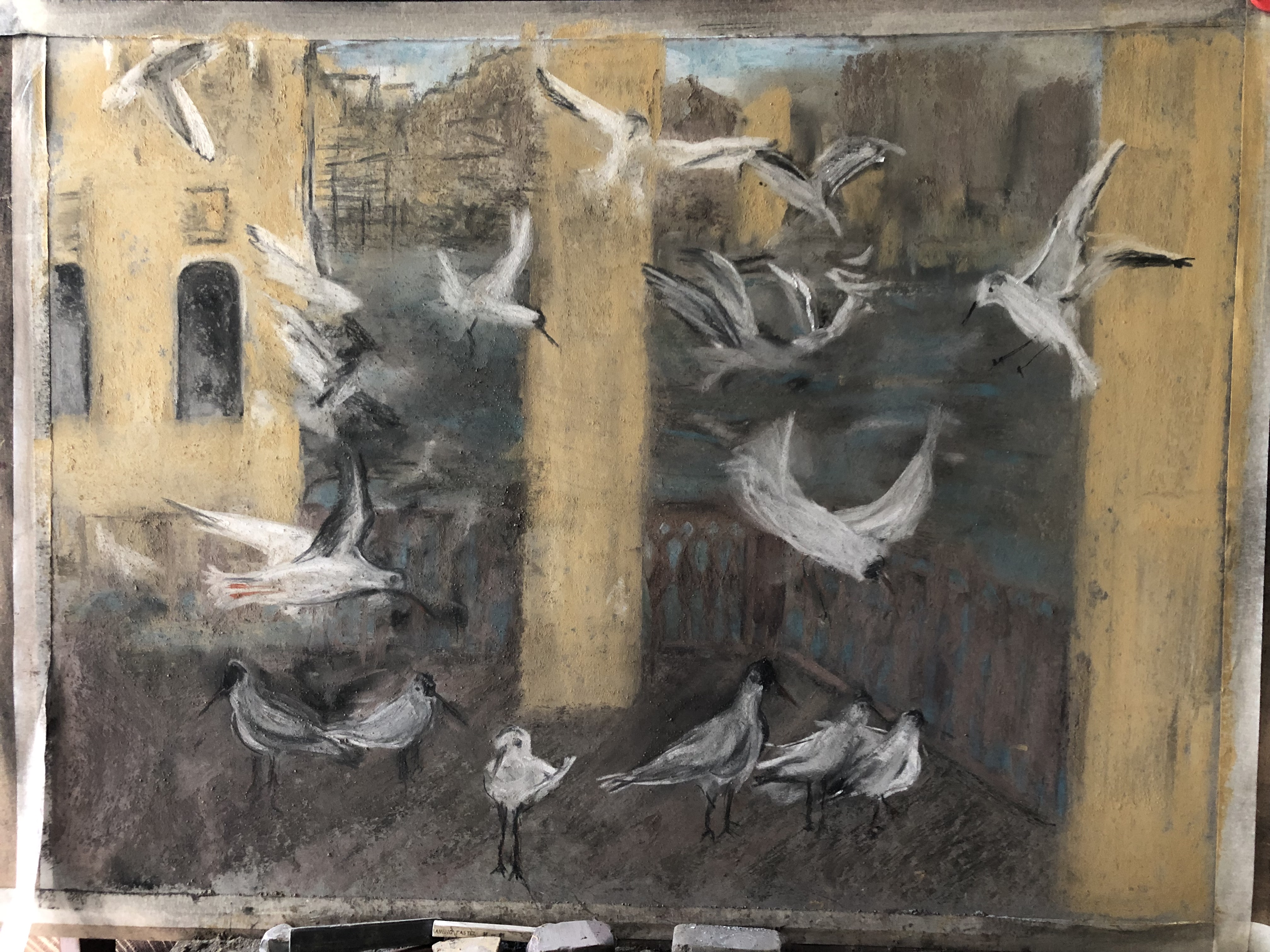
I think I enjoyed the chaos in the moments – it led me to seeing something of the tension between order and complexity of how groups network.

I hope to see the gulls back in town the coming winter season.
My tutor suggested: … “pursuing a series of larger works – rather than on final piece – you could free yourself up to be more experimental” This is reflect in my self -critique and I decide to get working on this before I submit my work for Assessment during May/July 2019.
My first attempt was an IPad drawing:

I like the blurriness idea….
My tutor recommended that I integrate the information into my work. I was challenged to look at the diagrams and data maps which I observed and how it could be developed into drawings. I realise that I need to take some risks and try and almost deconstruct what I think I saw during these images of the gulls flying and my knowing of them being in a process of migrating into the space I visited.

I tried these gulls in a flying pattern – with Jik on left over paper I used for Cyano printing in the sun. Migration is a seasonal displacement in the life of these birds – an intriguing phenomenon in nature.
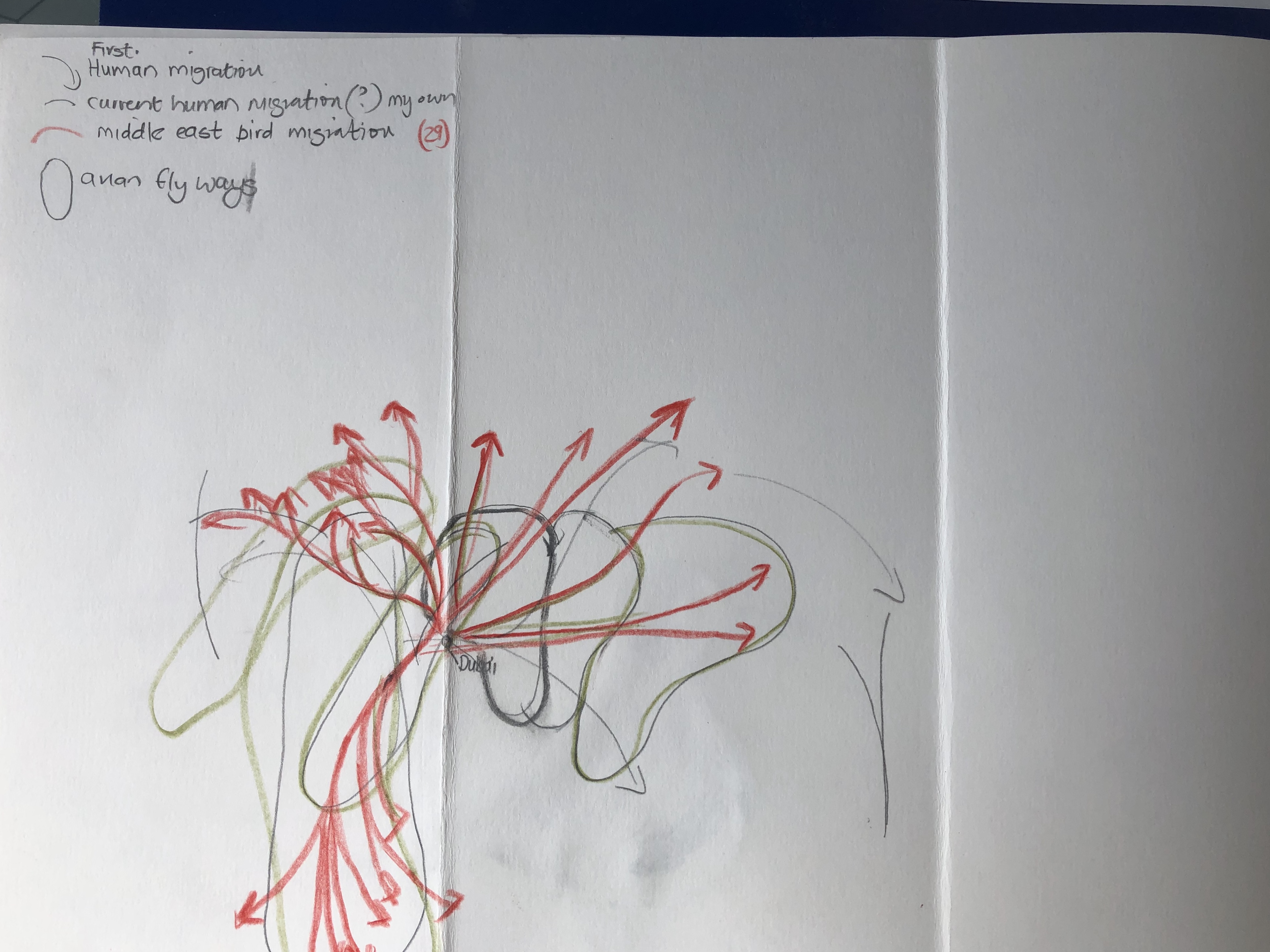
If one could visualise around 300 species only coming into the UAE area – Central Asia Flyway area

Above: I draw with an ink- dipped paintbrush and started forming patterns and forms of the birds flying in the sky. I used video footage to work with these ideas. Whilst doing this, I was thinking of the work of Vija Celmins – her almost obsession with detail and use of ‘found objects’. (Researched her approach on landscape her for part three of the studies) Her night-sky drawings comes to mind – here she worked with charcoal on white paper – the idea that she views her work as something between “Intimacy and Distance” resonates with me. I decided to do this drawing on Velum trace paper and with charcoal on grey paper.

I found the exercise intriguing – going with intuition, seeing chaos erupting and thinking about how these birds stay in their formations for thousands of kilometres to their final destination. There is safety in numbers: feel safe when we are interconnected and within a networking system. I am also intrigued with my own fascination with the details within these networks – there is beauty in this chaos – paradoxically there is also very a complex order in between. On the National Geographic website I read that, although migratory birds have been making their ‘thousand mile’ flights for millennia, we are just learning now to map these mesmerising journeys. I found great migration patterns of gull data, but only within the UK and Europe. The researchers used visual data through the use of GPS based movement tracking, is showing information on the movements patterns of different bird populations, how they navigate and what are the drivers of movement. – It is amazing to think that these birds understand the competitive advantage of moving.
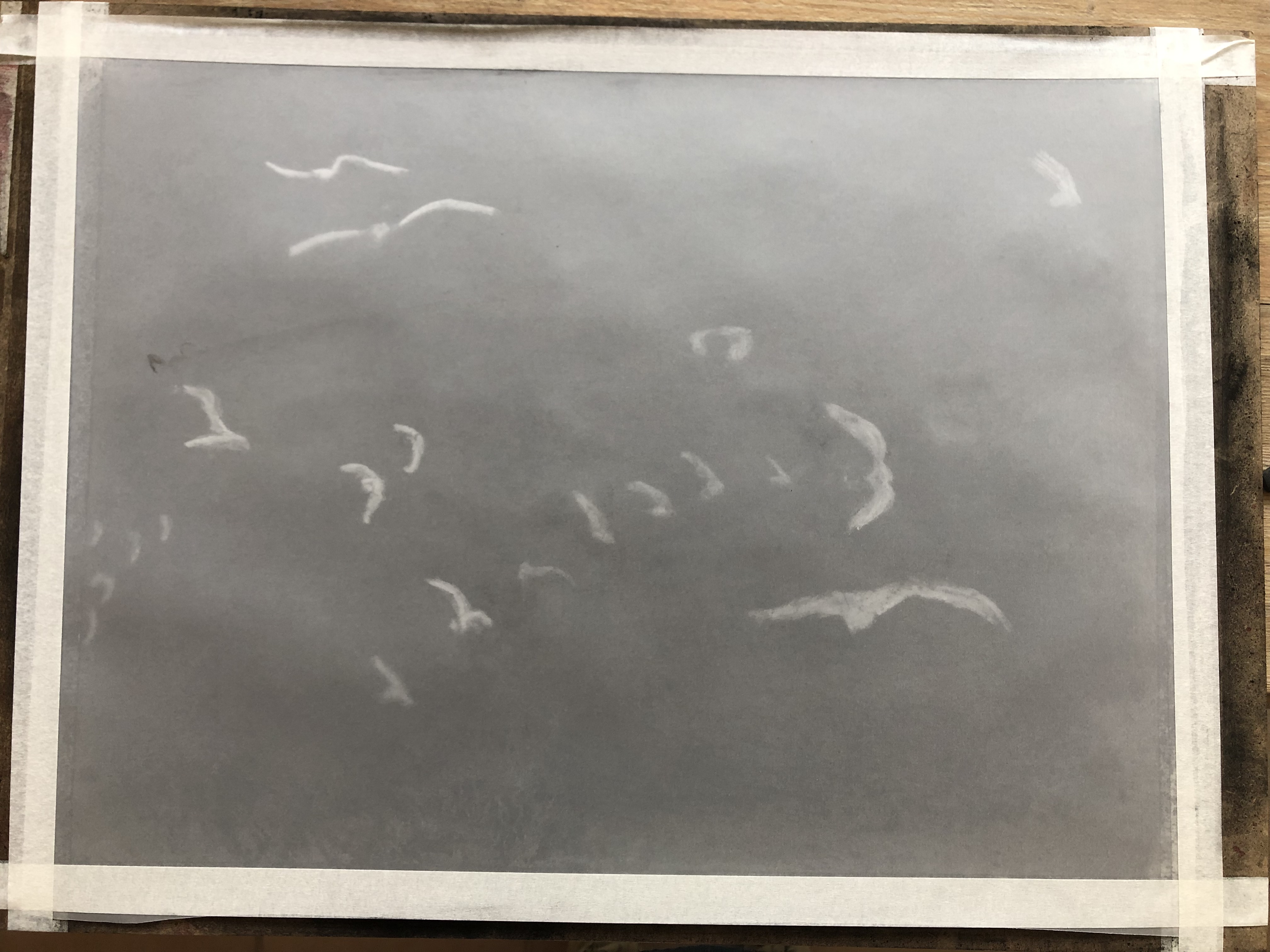
I tried Vellum paper on top of a charcaol drawing – made some lines to indicate fly ways, but not happy with the visual effects. I decide to go with the flat canvass and drawings of birds.

Above route map idea intrigues me and I will push further with my own art. I am motivated and inspired by the information I could gather and bring into my art. I am also frustrated that I could not do more for this assignment. I feel like I have only scratched the top layers of this project, being in such a ‘developed’ landscape of desert and harsh climate.
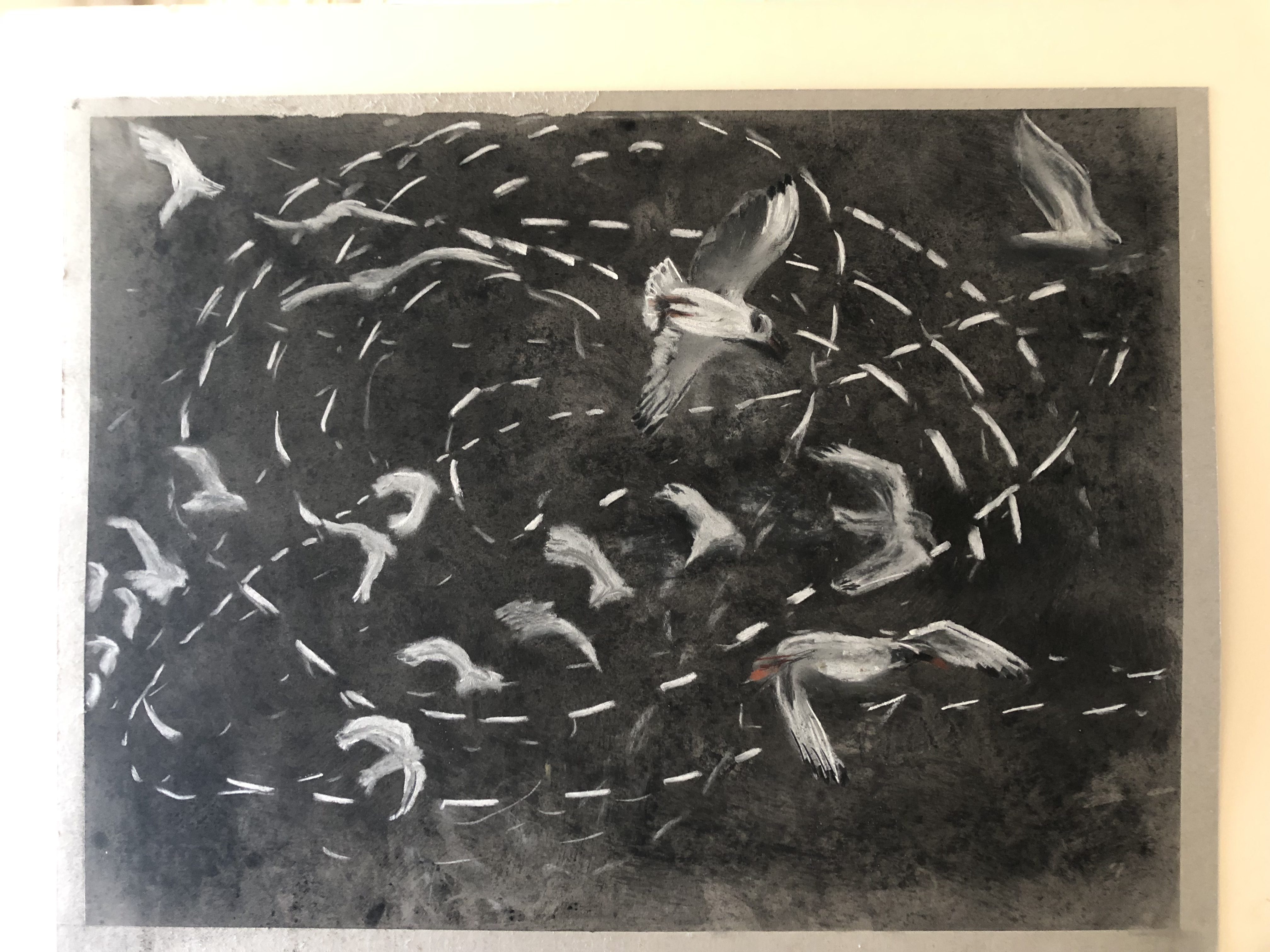
List of references
AL Maktoum, Sheik Mohammed bin Rashid, 2019 My Story 50 Memories from Fifty Years of Service, Explorer Publishing & Distribution, February 2019
Cornell Lab – e bird data from their website
Konzack, Gijsbers, Timmers, Van Loon, Westenberg and Buchin, 2018 Visual exploration of migration patterns in gull data. Reseachgate.net article accessed on 10 May 2019
World Migration Report, 2018 accessed online during March 2019
Wiwo.org 1995 report on Waders and other Waterbirds, accessed online during February and March 2019 ( p 1 -134)
Tate website for Vija Celmins image – downloaded on 12 May 2019
I read the following about rhino horn consumption in China. “In China, as Gao and fellow researchers recently reported in the journal Biological Conservation, the market is driven by interest in art and antiques purchased not as status symbols but as investment pieces. The difference might seem minor. But it reflects a disconnect that Gao said is rooted in cultural barriers and miscommunication — and could be an important obstacle to ending the illegal trade and poaching.” ( Washington Post, Sept 2016